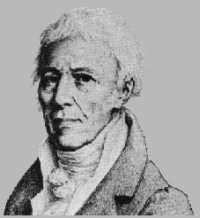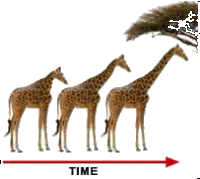 SKC Films Library SKC Films Library |
|
|
| SKC Films Library
>> Science >> Natural Science |
 Jean
Baptiste Lamarck Jean
Baptiste Lamarckproponent of "acquired traits" Jean Baptiste Pierre Antoine de Monet, Chevalier de Lamarck, was born at Bazentin-le-Petit, France, on August 1, 1744, the eleventh child of a landed gentleman. With three sons already in the military, Lamarck's father expected him to join the church, and he did indeed study at a Jesuit school in Amiens from 1755 to 1759. Shortly after his father's death, however, he entered the French Army, and served from 1759 to 1768. During his military service he distinguished himself during the 1761 German campaign and was promoted to officer status. An accidental injury forced him to leave the army, after which he worked as a bank clerk in Paris while studying medicine and botany. Lamarck began his scientific career as a botanist. His first major work in the field was Flore française (Flowers of France, 1778), in which he established a dichotomous system of contrasting characters by which any botany student could easily determine the species he was examining. The book gained him popularity, as well as admission to the Academy of Sciences and appointment as assistant botanist at the Jardin des Plantes (Royal Garden). From 1781 to 1782 he traveled throughout Europe and extended his knowledge of natural history. The results of this work were Dictionnaire de Botanique (Dictionary of Botany) and Illustrations de Genres, both of which were subsequently included in the Encyclopédie Méthodique (1785). In 1793, Lamarck was offered the zoological chair at the Musee National d'Histoire Naturelle, where he was expected to lecture on the Insecta and Vermes classifications of animals as described by Linnaeus. Despite knowing very little about either group of animals, Lamarck became the first scientist to distinguish invertebrates from vertebrates by the presence or absence of vertebral column, and the first to describe the groups Crustacea, Arachnida, and Annelida. His most important work in this field was Histoire naturelle des animaux sans vertèbres, which was published in multiple volumes from 1815 to 1822. Lamarck began losing his vision around 1818, and eventually became totally blind. He continued to work, however, with the assistance of his daughters.
Lamarck was struck by the similarities of many of the animals he studied, and was impressed by the ever-growing fossil record. What he saw led him to believe that the form of any given organism was not fixed, as many of his contemporaries believed. Instead, he argued that as environments changed organisms had to change their behavior in order to survive. If an animal began using an organ more than it had in the past, the size of that organ would increase during its lifetime. For example, if a giraffe stretched its neck to reach higher leaves, a "nervous fluid" would flow into its neck and make it longer over time. Its offspring would then inherit the longer neck, and continued stretching would make it longer still over subsequent generations. Meanwhile, organs that were no longer being used would shrink. Lamarck called his theory the "Inheritance of Acquired Traits," a phrase he first published in 1801. Like many of his contemporaries, Lamarck believed that life had begun through spontaneous generation. Unlike those same contemporaries, however, he claimed that new primitive life forms sprang up throughout the history of life, rather than all at one time. Lamarck's theories were mocked and attacked by his contemporaries, most of whom were more upset by the lack of "God's work" than by the theories themselves. Never able to gain respect from his peers, he died in poverty and obscurity in Paris on December 18, 1829. WEB SOURCE SEE ALSO |
SKC Films Library >> Science >> Natural Science This page was last updated on 01/10/2017. |
 His Theory
of Evolution
His Theory
of Evolution